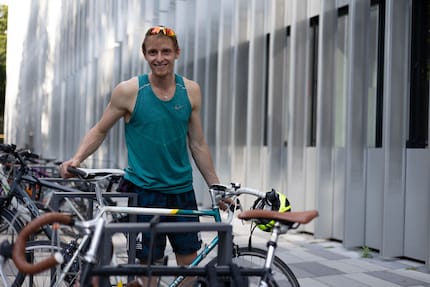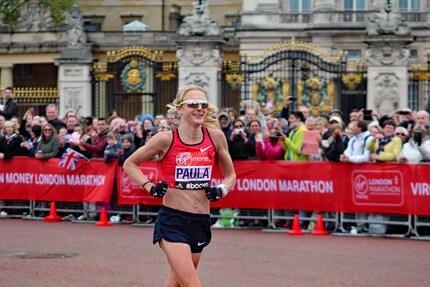
Background information
Project Half Marathon: fitness test causes cramp
by Oliver Fischer

When you’re running, it’s not just your maximal oxygen uptake that counts. How economically your body is functioning is of almost equal importance. I spoke to sports scientist Dr. Oliver Quittmann about visual surprises, physiological differences and the influence of running technique.
But what other factors play into this? And how can you improve your running economy? Given that my own deficits are much more significant, I’ll need a more detailed explanation of the term first.
The question of all questions is, of course, how did she do it?
Studies suggest that at this elite level, it’s less about achieving an ever-increasing maximal oxygen uptake (VO₂ max) than it is about economising your running speed. That worked really well for her over large training volumes. She’d always incorporated interval training, but tightened up her training volumes too. What we can assume here is that her running economy improved.
Simple writer and dad of two who likes to be on the move, wading through everyday family life. Juggling several balls, I'll occasionally drop one. It could be a ball, or a remark. Or both.
Interesting facts about products, behind-the-scenes looks at manufacturers and deep-dives on interesting people.
Show all
Background information
by Oliver Fischer

Background information
by Patrick Bardelli

Background information
by Patrick Bardelli
Energy consumption is a hot topic at the moment – and not just when it comes to heating your home. When you’re running, it springs to mind with every step. «I, for one, am very uneconomical,» says sports scientist Dr. Oliver Quittmann of his own performance. This means that for every kilometre he runs, he needs a relatively high volume of oxygen per kilogramme of body weight. As a scientist, Oliver conducts research in the field of performance diagnostics. As a triathlete, he’s keen to get the most out of his athletic potential. While we’re discussing the body’s energy supply routes and the importance of maximal oxygen uptake, another topic keeps coming up: running economy. That’s basically the question of how efficiently the body works. «There are huge variations within running economy. Factors such as tendon characteristics are much more important than in cycling,» says Oliver, who’s forced to compensate for his running economy deficits with a high maximal oxygen uptake.

What is «running economy»?
Dr. Oliver Quittmann: What’s deemed as «economical» differs depending on the scientific discipline. Taking a biomechanical view, I’d maybe look at muscle activation at a particular joint angle. Alternatively, I’d take an interest in certain mass moments of inertia, which I can then model in a detailed way. As far as physiology is concerned, I simply look at how much distance I’ve covered, how fast I’ve done it and how much oxygen I took in. From a physiological perspective, it’s not crucial to know how those things came about or how I was moving.
Even though it isn’t crucial physiologically in your view, can you tell how economically someone runs at first glance?
From the analyses we’ve done, I really have to say that a nice running movement isn’t necessarily an economical one. I’ve had people on the treadmill who’ve made me think, jeez I hope they don’t trip! Their movement looked extremely uneconomical, but then physiologically, they came out with top economy scores. It happens the other way round too. There are people with very far-reaching strides and upright posture who consume quite a lot of energy. It’s dependent on so many variables.
What sort of factors are at play?
One obvious point is physique. For example, my calves are very pronounced in relation to my thighs. That’s obviously a lot of mass, meaning a relatively high moment of inertia. For people with long tendons and narrow calves, the conditions are different. We could look at it the same way for height, leg length, or tendon characteristics. A cursory glance at someone’s body gives you a first impression, but there are still numerous components you could look at.
If you look into the topic of running economy, you’ll quickly come across longtime marathon world record holder Paula Radcliffe. Her maximal oxygen uptake hasn’t gone up much over the years, but her best times have improved drastically.
Andrew Jones at Exeter University summarised those results – and they’re incredibly interesting. Although we say that maximal oxygen uptake tends to be crucial, it wasn’t relevant at all at her high level. One factor that affected her performance was the fact her lactate curve always shifted further and further to the right. And her improved running economy had an even greater impact.

The differences in her performance were significant, and as a world-class athlete, all eyes were on her. Was there a visible change in her running style?
Although the measured differences are like night and day, I’d guess any changes in her running style would be barely noticeable. You might see small changes in individual running movements, but in my experience, you might not even notice it. It might be less of a mechanical factor, and more of a physiological one – a question of how well the body handles oxygen.
So does that mean running technique plays more of a secondary role?
I wouldn’t draw the conclusion that we should totally disregard running technique. In particular, people who’ve never given any thought to their technique before can always get something out of the running ABCs or doing strength training (which also has a strong association with running economy). Certain aspects of it have good mechanics-based explanations, such as keeping your elbows relatively steady or lengthening your stride. I mean, if you put your foot too far forward, you slow yourself down. The ground reaction force pushes against you. You should plant your foot close to your body, or under the body’s centre of gravity. Certain principles obviously apply, but I can’t directly translate a nice running style into physiological terms.
How does strength training contribute to a more economical running style?
A stable core, for example, is good in any sport because it involves transferring forces. After all, I want to move my body. I need to transfer the force from my legs via my torso, forming a kind of counterweight with my arms. Without a stable core, I can’t generate a force that strong. Regardless of whether you want to be economical in sprinting or endurance, you should aim to have as strong a core as possible, so that you don’t rotate too much. If I see ten runners, I see ten different running styles. Some of them rotate their upper body a lot and could make progress by doing stability training. Others outstretch their arms the whole time. Some keep their arms quite stiff, with movement coming from their elbows as opposed to their shoulders. There are various things we’d tend to judge as uneconomical.
As well as physical factors, there are also material ones. It’s definitely more economical to run while wearing shoes with reactive carbon plates.
There’s strong evidence to support that, and the data is very clear. That’s why we said in our studies that we wouldn’t allow shoes with carbon plates when evaluating running economy. If we’d done that, the study would’ve been skewed from the get-go. Carbon shoes, especially the Nike ones, are very much backed by science. If you want to bring science and practice together in one example, my go-to is always Kipchoge’s record-breaking run in 2019. Everything came together – the performance diagnostics, the shoe material, the meteorology, the nutrition and the drag components. It was such a science-based project – and really impressive.
These developments in footwear have rewritten the rulebook and have long since become established in mainstream sport.
I always see my friends and acquaintances wearing these sorts of shoes too. If it’s people who’re doing 10Ks in 29 minutes instead of 29:30, I say, okay, they’re doing some good. If they’re still at it one hour after starting the race, I don’t know if those kinds of shoes are really necessary. Not only that, but the material should match the wearer’s ability.
In terms of gear, these shoes were a game changer. What sort of development could mean crucial progress for performance diagnostics?
You can already get skin sensors which measure blood sugar levels. This helps athletes to choose a nutrition strategy for when they’re competing. If there were such a thing for lactate and you could see your lactate concentration level on a watch, endurance sport would probably change significantly. There have been working groups looking at this, but it doesn’t seem to be as simple as glucose. We’re not there yet.
Dr. Oliver Quittmann researches and teaches at the German Sport University Cologne, focusing on endurance sports among other subjects. His studies involve various performance diagnostics methods, primarily examining the glycolytic metabolism. Alongside his work, the 31-year-old runs the video podcast «Exercise Inside Out» and shares his research results in science slams (both in German). He regularly publishes much of his teaching and research content on his YouTube channel (content in German).

DJI Osmo Action 4 Standard Combo
120p, Bluetooth, Wi-Fi